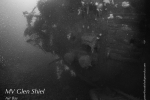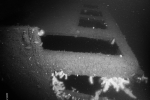The Glen Shiel was a steel motor coaster launched from the Peterhead yard of Livingston & Co Ltd (Yard No 5) on 10th November 1959. She measured 105.8′ x 22.4′ x 8.9′ and her tonnage was 196 gross tons, 89 net tons. She was powered by a 4 cylinder 2SA by Alpha-Diesel A/S delivering 310 brake horse power. The Glen Shiel was owned by G & G Hamilton Ltd., of Glasgow and at the time of her loss she was under charter to Glenlight Shipping Limited of Glasgow.
The Glen Shiel left Ayr Harbour around 12.40am on 29th June, 1973 bound initially for Shieldhall in Glasgow, her final destination being Portree with a cargo of 215 tons of coal. Aboard were five crew and one passenger under command of her master Tom West.
She proceeded north west across Ayr Bay in a stiff south-westerly breeze and although the sea was not rough, spray was continually blowing over her port rail. Prior to departing Ayr, the tarpaulins had not been spread over the main hatch boarding and this allowed spray to run between the hatch boards into the hold. Over a period of time, thought to be just over half an hour, the steady build up of water in her main hold suddenly caused the coaster to develop a pronounced list to port and she soon began to founder. The crew were only alerted to the danger shortly before she sank, probably due to the gradual build-up of water prior to a final deluge. This may, in part, account for the loss of five of the six persons aboard.
James Scott (21) of Portrush, the sole survivor later commented ” I was below at the time in my bunk, when the mate John McInnes shouted: It will not be safe if you stay down below. At that point the ship took a heavy list to port and I heard the crashing of crockery in the galley. I scrambled up to the wheelhouse and noticed that the port side of the ship was under water. I saw the mate jump into the sea with a lifebelt and I followed him, but my lifebelt caught in the rigging and I went over the side without it“. James and the mate were joined by the second engineer, the only men aboard known to leave the ship before it sank. The three remained in the water for three hours before the second engineer was unable to remain afloat and tragically sank from view, to be followed 30 minutes later by the mate. James managed to remain afloat for another 3 hours before being washed ashore on Troon’s South Beach where he was later discovered by a local resident and taken to hospital in Ayr. He made a full recovery.
A formal investigation into the tragic events of the 29th June was later held in Glasgow Sheriff Court in late March 1974. The investigation found that the loss of five lives and the vessel was caused by the failure of the Master to properly prepare the ship for sea.
The wreck of the Glen Shiel is located approximately 2.75 miles WNW of Ayr Harbour in position 55°29.166’N, 004°43.078’W. She lies on her port side oriented 000°/180° with her bow pointing south. Seabed depths around the wreck average 25 metres while the least depth is 19 metres.
When dived in July 2022 we observed increased deterioration of the hull and superstructure. Holes are now appearing on the upper starboard side of the hull, allowing light to filter through into the now empty hold and focsle. The cargo of coal carpets the surrounding seabed, especially on the east side of the wreck. The bridge is more open and it is possible to swim through this area with care. The stern is still intact although recent diver activity is visible, the rudder is over to port and the boss of the propellor is still in place, the blades were removed in 1977. The wreck is covered with soft and hard corals, and provides a habitat for small fish and crustaceans. Visibility is generally 3-4 metres or greater.
The wreck is completely intact except for her mast and propeller which were removed by a commercial diving company in 1977. Below is a link to a video shot in 1997.



















































